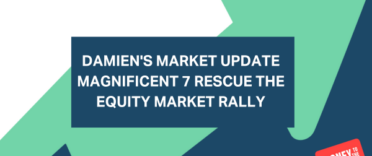Welcome to the latest episode of my monthly YouTube show where I discuss what is happening in investment markets and what to look out for. This month I explain why all possibilities are still on the table when it comes to investment markets.
Each show lasts between 5-10 minutes and is aimed at DIY investors (including novices) seeking contemporary analysis to help them understand how investment markets work.
Subscribe to my YouTube channel to receive my weekly analysis of investment markets or alternatively, you can listen via my weekly Midweek Markets podcast below.
Damien's Market Updates monthly podcast
Other ways to watch, listen and subscribe
You can listen to other episodes and subscribe to the show by searching 'Money to the Masses' on Spotify or by using the following links:
Abridged transcript - Damien's Market Update - March 2023
Netwealth’s wealth management service combines a comprehensive low-cost investment solution with access to qualified advisers.
They recently launched MyNetwealth – a digital dashboard that combines all your savings and investments – from multiple providers – in one place.
MyNetwealth's wealth planner tool helps you visualise your current wealth and apply it to your future needs. It takes into account various factors such as age, investments, pensions, tax wrappers, and expected contributions or withdrawals – and calculates the likelihood of you achieving your goals. Daily updates make it easy to track the value and performance of your wealth.
MyNetwealth also provides a library of useful personal finance content and if you ever need advice or guidance, their highly qualified team is always there to help.
You can find out more information and sign up for MyNetwealth in 30 seconds visit my.netwealth.com. Please remember, the value of investments can go down as well as up, so you may get back less than you invest.
Last month’s market update was titled “Keep an eye on the dollar”. At the time the market consensus was for the US dollar to continue to weaken further and many investors had gone all-in, betting that inflation had peaked and central banks would stop tightening monetary policy (which is a fancy way of saying they would stop raising interest rates). Greed was the overriding emotion driving investor behaviour, according to the CNN Greed and Fear Index. We saw the FTSE 100 push to new all-time highs and the S&P 500 break out of its downtrend channel that dated back to the start of 2022.
But I closed out the show by warning that if the market narrative or assumptions, especially the “Fed pivot” narrative, proved false, it could cause a shake-up in the US dollar index, which in turn could cause the rally in bonds and equities to unravel.
At the time the US dollar index was showing some signs of life moving from just above 101, to just below key level of 104 and its then 50 day moving average. I suggested that if the US dollar index broke above 104 and ultimately 105 then we could see a reversal of the asset price moves we’d seen up to that point in 2023.
As it turned out, the US dollar index deliberated for the first half of February before breaking above those key technical levels I highlighted, meanwhile bond yields started to move higher as bond investors began worrying about inflation (again) and the robustness of the US economy. Meanwhile, equity investors seemed either unfazed or unbelieving.
It turned out that the bond market was right to be worried as subsequently released US economic data showed that the US economy was proving stronger than expected. Then when new inflation data suggested that inflation might prove stubborn, equity markets were sent reeling and the 2023 rally in US equities began to unwind. It was a pattern repeated in the eurozone and the UK as new economic data on this side of the Atlantic also began to challenge the prevailing investor narrative.
Ultimately, February was a wake-up call for markets that we could see higher interest rates for longer. That has been something many equity investors have had trouble believing.
By the end of February, the equity market winners and losers list could have been renamed the stronger US dollar winners and losers list. The FTSE 100 rose 1.35% while the Nikkei rose 0.43%, as both benefited from weaker domestic currencies versus the US dollar. European equities also performed well, up around 1.5% as measured by the FTSE Eurofirst 300.
At the other end of the scale the laggards were emerging markets equities and US equities - in local currency terms. The MSCI Emerging Market Index was down 4.71% while the S&P 500 fell 2.61%. Meanwhile bond yields rallied meaning the value of most bond funds took a hit. The 10 year US year treasury yield rose above 3.9% by the end of February to its highest level since November.
The combination of weaker equity markets and bond markets in tandem started to feel like 2022 once again. But now we are in March. so can the bond market give us any hints as to whether the pullback in equity markets will continue or stabilise. After all, it pre-empted the equity market weakness in February. Interestingly, March was only hours old when we saw another seismic move higher in bond yields. Stronger than expected leading economic indicators in the eurozone, China and the US, combined with higher than expected eurozone inflation data saw bond yields spike higher globally.
In the US, markets began betting that the US Federal Reserve’s benchmark interest rate would hit 5.5% by July 2023, up from the previous predicted peak of 5.2% which was the consensus only two weeks ago. Unsurprisingly US bond yields burst higher with the 10 year US treasury yield breaking above 4%.
It was a similar pattern in the UK, with the 10 year UK gilt yield rallying to its highest level since late October, a month after the Bank of England had to intervene to calm bond markets following the ill-fated mini-Budget. The increase in yields was also seen across shorter-dated gilts and it meant that rates on the best fixed-rate mortgages have started slowly drifting higher in the UK.
Unsurprisingly equity markets took another wobble in March after initially trying to break higher once again, but the wobble is not yet significant. It seems that equity markets are now suggesting that robust economic data is positive news, believing that the economy can in fact withstand higher interest rates. If February was characterised by equity markets ignoring the bond market's warning of robust inflation and stronger than expected economic data. March has started off with equity markets heeding the warning and either downplaying it or hijacking it as a reason that the equity market rally will continue. The danger is that when equity market narratives are fickle, the corresponding market trends can be too.
It feels like we are at an inflexion point once again, with all possibilities still on the table, including a breakout in stock markets or the bear market taking hold once again. The same can be said for bond markets. Between now and the next show we have key central bank policy decisions from the likes of the European Central Bank, the US Federal Reserve and the Bank of England. These are likely to cause bouts of volatility in investment markets. The same is likely whenever new economic data is released, especially if it relates to inflation. If we’ve learnt anything from the last month, it’s that it’s a brave person who goes all-in on with their bets as to what will happen next with bond and equity markets. For now keep watching the US dollar and bond yields and if you want an equity market threshold to watch then if we break below 3900 then the US equity market rally will be under threat and the bear will likely return



